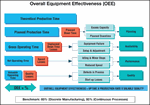A Simple Guide to Spindle Repair
Understand the causes of spindle failure and the steps for proper repair.

Always monitor spindle health. Make sure the spindles are properly lubricated and minimize contamination. Photo Credit: Northland Tool and Electronics
The spindle is an integral part of any functioning machining center. If a spindle is broken or not working correctly, the machine will not perform to its highest potential or at all. The spindle repair process is in-depth and takes multiple steps, so consider a trained professional. However, the following is a general rundown of spindle health and the repair process.
To minimize machine downtime and mitigate repair costs, always monitor your spindle’s health and err on the side of caution. Investing in regular inspection is much less expensive and time-consuming than repairing or replacing a spindle.
Identify the Cause
While a spindle experiences normal wear and tear over its lifetime, some common issues can cause it to fail prematurely. Here are six typical causes of spindle failure:
- Bearing failure caused by improper lubrication, manufacturing, storage mishandling or misalignment.
- Contamination caused by oils or other liquids, gases or grinding swarf, depending on the nature of the manufacturing process that the spindle serves.
- Worn tapers causing fretting, spindle runout and manufacturing deficiencies.
- Damage from a spindle crash, even a seemingly minor crash, can have dire consequences.
- Worn or out-of-tolerance housings crushing the bearing too tightly or allowing too much free play, resulting in misalignments and accelerated bearing wear.
- Loose journal bearings creating a situation where the inner race of the bearing could spin on the shaft.
Additional common causes of spindle failure include lack of regular maintenance, overuse, elevated temperature, overloading, chiller failure, lubricator failure, crash and contamination.
Make a Plan
Here are four steps in the spindle repair process and ways to minimize spindle downtime:
- Evaluate – The repair technicians determine the cause of failure, which is essential to the repair process. Any issues with the spindle — and the entire drawbar system — are considered and documented.
- Break Down – The technician breaks down the spindle into component parts while examining the pieces for damage, defect or excessive wear. This process should be documented with pictures and detailed notes.
- Repair – Assemble all the spindle components (including any new parts ordered) and perform a rigorous testing process, including dynamic balancing, and thermal and vibration analysis, depending on the spindle type.
- Inspect – Perform a final quality inspection.
To minimize spindle repair, always monitor spindle health. Ensure the spindles are properly lubricated and minimize contamination, including keeping up with routine maintenance and checking for any changes in the spindle’s performance. Then keep a detailed monthly or quarterly data report. Include taper runout, test bar runout, drawbar force, the temperature at a particular speed and electrical load in the data report. Check your air dryers. Increased humidity puts higher demands on your air systems and can lead to water getting to your spindle bearings (in oil/air applications). Humidity is much easier and cheaper to address now with an air dryer than later with a spindle repair.
Also, shut down machines properly before vacations. If you are shutting a machine down for a week, take the time to wipe down the spindle to remove any coolant from the external surfaces, preventing accidental ingress of coolant to the bearings. After an extended downtime, running the spindle through a warm-up procedure is always good practice. If your machine does not have this capability, keep an eye on the temperature of the spindle when it starts back up.
Educate yourself and your technicians about spindle health and preventative maintenance. The better care you take of your spindles, the fewer repairs and replacements, limiting unforeseen machine downtime.
Related Content
How to Eliminate Chatter
Here are techniques commonly used to combat chatter and guidelines to establish a foundation for optimizing the moldmaking process.
Read MoreHow to Generate the Ideal Tool Path for High-Level Accuracy and Finish
When a mold builder can’t compromise part accuracy and surface finish, CAM software with specialized programming strategies is essential.
Read More3D Printing Enables Better Coolant Delivery in Milling Operations
Just like 3D printing enabled conformal cooling channels in molds, additive manufacturing is now being used to optimize coolant delivery in cutting tools.
Read MoreRead Next
The Danger Zone
Spindle crashes can have costly consequences. Collision protection systems can help minimize the damage.
Read MoreA Solution for Spindle Repair
Getting a spindle repaired or replaced to get it back up and running is critical in any shop, but that is often not a simple process. Take a look at this spindle repair shop's solution.
Read MoreDeveloping an Effective Machine Tool and Spindle Service Program
To get ahead of the competition your shop must use and maintain its available resources by achieving a high level of overall equipment effectiveness
Read More





















